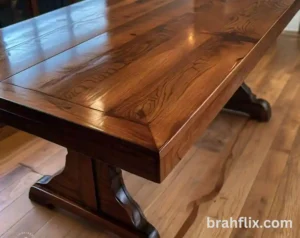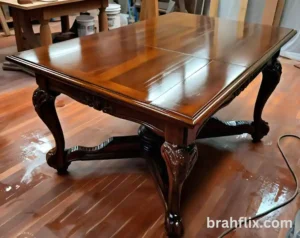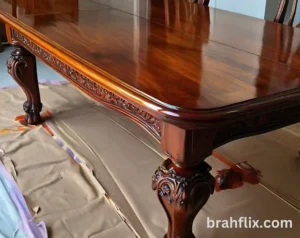Introduction
Wooden dining tables are a staple in many households, prized for their natural beauty and durability. However, they are not immune to damage, with scratches being a common concern for many owners. Learning how to protect wooden dining table from scratches is essential for maintaining its elegant appearance and extending its lifespan. This comprehensive guide will explore various techniques and tips to safeguard your table from scratches and other forms of wear.
Key Takeaways:
- Effective methods to prevent scratches on wooden dining tables.
- Practical advice for maintaining the table’s finish and appearance.
- Essential products and tools to use for protecting and restoring your table.
1. Understanding the Causes of Scratches on Wooden Dining Tables
Scratches on wooden dining tables can stem from various sources, each requiring a different approach for prevention and repair. Understanding these causes can help in implementing effective protection measures.
Common Causes of Scratches:
- Dining Utensils: Forks, knives, and other utensils can leave scratches, especially if used improperly.
- Sharp Objects: Items like keys, pens, or even metal bowls can scratch the surface.
- Furniture Movement: Sliding chairs or placing objects on the table can create friction, leading to scratches.
- Pet Claws: Pets, particularly those with sharp claws, can inadvertently scratch the table.
Preventive Insight:
Identifying the main sources of potential damage can guide you in taking appropriate measures to protect your table.
2. Applying Protective Coatings to Your Wooden Dining Table
One of the most effective ways to safeguard your table is by applying protective coatings. These coatings create a barrier that helps resist scratches and other types of damage.
Types of Protective Coatings:
- Polyurethane: Offers a durable, clear finish that protects against scratches, stains, and water damage. It comes in both oil-based and water-based varieties.
- Lacquer: Provides a high-gloss finish and good protection against scratches, though it may require regular reapplication.
- Shellac: A natural resin that offers a beautiful finish and moderate protection but is less durable compared to polyurethane.
Application Tips:
- Ensure the table surface is clean and dry before applying any coating.
- Apply the coating in thin, even layers, allowing each coat to dry thoroughly before applying the next.
- Use a high-quality brush or applicator to avoid streaks and bubbles.
Recommendation:
For the best results, consider using a combination of coatings. For instance, a polyurethane base coat followed by a lacquer top coat can offer enhanced protection and a polished finish.
3. Using Table Protectors and Covers
Table protectors and covers are simple yet effective tools for preventing scratches and other damage. They act as a physical barrier between the table surface and potential sources of harm.
Types of Table Protectors:
- Tablecloths: Fabric covers that can absorb spills and prevent scratches. Opt for thick, high-quality fabrics for better protection.
- Table Mats: Placed directly on the table, these mats can shield against scratches from dishes and utensils.
- Glass Covers: Transparent glass or acrylic covers can protect the table while allowing the wood’s natural beauty to show through.
Benefits of Using Table Protectors:
- Easy Maintenance: Tablecloths and mats can be easily washed or replaced.
- Visibility: Glass covers allow you to showcase the wood grain while protecting it.
Tip:
Choose table protectors that complement your table’s style and finish. Ensure they fit well to avoid slipping or bunching.
4. Implementing Proper Table Use and Maintenance
Routine use and maintenance practices play a crucial role in preserving the condition of your wooden dining table.
Best Practices:
- Avoid Placing Hot Items Directly: Use trivets or hot pads to prevent heat damage, which can weaken the table’s finish and make it more prone to scratches.
- Use Coasters and Placemats: Protect the table from scratches caused by glassware and utensils.
- Clean Regularly: Dust the table with a soft, dry cloth to prevent grit from causing scratches. Use appropriate wood cleaners for deeper cleans.
Cleaning Techniques:
- Dusting: Use a microfiber cloth to gently remove dust and debris.
- Cleaning Spills: Wipe up spills immediately to prevent damage. Use a damp cloth and avoid soaking the wood.
Tip:
Avoid using abrasive cleaners or scrubbing pads that can scratch the surface. Opt for gentle, wood-specific cleaning products.
5. Choosing the Right Furniture Legs and Feet
The type of furniture legs and feet on your dining table can impact its susceptibility to scratches.
Options for Protecting Furniture Legs:
- Furniture Pads: Adhesive pads that stick to the bottom of table legs can reduce friction and prevent scratches on flooring and table surfaces.
- Rubber or Felt Feet: These provide cushioning and help protect the table from direct contact with the floor or other surfaces.
Benefits of Furniture Pads:
- Protective Barrier: They create a soft layer between the table legs and the floor, minimizing scratches and scuffs.
- Ease of Installation: Simple to apply and replace as needed.
Tip:
Regularly check the condition of furniture pads and replace them if they become worn or damaged.
6. Preventing Scratches from Chairs and Other Furniture
Chairs and other furniture in the dining area can inadvertently cause scratches on your table. Here’s how to prevent this:
Strategies for Chair Protection:
- Chair Glides: Attach glides to the bottom of chair legs to reduce friction and prevent scratches.
- Protective Felt Pads: These can be adhered to the underside of chair legs to cushion movement.
Furniture Placement Tips:
- Adjust Chair Height: Ensure chairs are appropriately sized for the table to prevent them from scraping the table’s edge.
- Avoid Dragging Chairs: Encourage lifting chairs when moving them to prevent them from scraping the table surface.
Recommendation:
Regularly inspect and replace chair glides and pads to maintain their effectiveness.
7. Repairing Minor Scratches and Nicks
Even with the best protection, minor scratches and nicks can occur. Here’s how to repair them:
Steps for Repairing Scratches:
- Clean the Area: Wipe the scratched area with a damp cloth to remove any dirt or debris.
- Apply a Wood Filler: For deep scratches, use a wood filler or crayon that matches the table’s finish. Follow the manufacturer’s instructions for application.
- Sand and Polish: Once the filler is dry, lightly sand the area with fine-grit sandpaper and apply a matching wood polish or finish.
DIY Repair Tips:
- Use a Wood Repair Kit: These kits often come with everything needed to fix minor damage and can be a quick solution.
- Test First: Always test repair products on a small, inconspicuous area before applying them to the visible surface.
Tip:
For significant damage, consider consulting a professional for repair and refinishing.
8. Considering Professional Restoration Services
For extensive damage or valuable tables, professional restoration services can be a viable option.
What to Expect from Professional Restoration:
- Assessment: Professionals will assess the damage and determine the best approach for restoration.
- Refinishing: This may involve sanding, staining, and applying a new finish to restore the table’s appearance.
- Protection: Professionals can also apply high-quality protective coatings to extend the table’s life.
Benefits of Professional Services:
- Expertise: Skilled technicians can handle complex repairs and achieve a high-quality finish.
- Value Preservation: Helps maintain or increase the value of antique or high-end furniture.
Recommendation:
For valuable or antique tables, professional restoration can be a worthwhile investment to ensure quality care and longevity.
9. Maintaining the Finish of Your Wooden Dining Table
Proper maintenance of the table’s finish is crucial for preventing scratches and preserving its appearance.
Maintenance Tips:
- Regular Polishing: Apply a wood polish or conditioner periodically to maintain the finish and protect against scratches.
- Avoid Direct Sunlight: Prolonged exposure to sunlight can cause fading and weaken the finish.
- Control Humidity: Maintain a stable humidity level to prevent the wood from expanding or contracting, which can lead to damage.
Recommended Products:
- Wood Conditioners: Help nourish and protect the wood, keeping it supple and less prone to scratches.
- Furniture Polishes: Provide a protective layer and enhance the wood’s natural shine.
Tip:
Follow manufacturer guidelines for any care products used to ensure compatibility with your table’s finish.
Frequently Asked Questions (FAQs)
1. How can I prevent scratches from pets on my wooden dining table?
Use furniture covers or place a protective mat where pets are likely to interact with the table. Regularly trim pet claws to minimize damage.
2. What is the best way to clean and maintain a wooden dining table to avoid scratches?
Dust regularly with a soft cloth, clean spills promptly, and use a wood polish to protect the surface. Avoid using abrasive cleaners or scrubbing pads.
3. Are there specific products I should avoid to protect my wooden dining table from scratches?
Avoid harsh chemicals, abrasive cleaners, and metal or rough cleaning tools that can scratch the surface. Stick to gentle, wood-specific products.
4. How often should I apply protective coatings to my wooden dining table?
The frequency depends on usage and wear. Generally, applying a protective coating every 6-12 months can help maintain the table’s finish.
5. Can professional restoration help with deep scratches or damage?
Yes, professional restoration services can repair deep scratches and damage, restoring the table’s appearance and providing long-term protection.
Conclusion
Protecting your wooden dining table from scratches involves a combination of preventative measures, proper maintenance, and timely repairs. By understanding the causes of scratches and implementing effective protection techniques, you can keep your table looking beautiful and functioning well for years to come.
Have you tried any of these methods to protect your wooden table? Share your experiences or ask questions in the comments below. For more tips on furniture care and maintenance, explore our other blogs and stay informed!